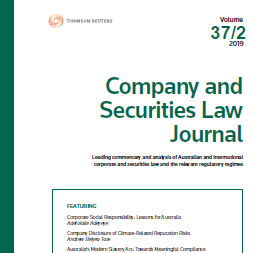“Corporate structures are a haven for those seeking to minimise payment of employee entitlements, and the mechanisms are diverse,†writes Professor Helen Anderson in the current issue of the Company and Securities Law Journal (Vol 36 Pt 7).
In “Piercing the Corporate Veil to Reach the Money for Employees: Why, How and Where to Next?â€, Anderson considers the increasing exploitation of the corporate form by Australian companies to “deliberately†offload debts, with the implications including non-payment of employee entitlements. The legal distinctness of each company, even in corporate group structures, enables this circumvention of corporate responsibilities.
Anderson discusses the various ways in which supply chains, labour hire arrangements, sham contracting, phoenixing – have all resulted in an explosion of scandals around the non-payment or underpayment of employees in recent years.
Illegal phoenix activity, for example, where on insolvency an employer company’s strict liability for employee entitlements is “thwarted†while its business, minus its debts, is transferred to a successor company. Again, in a supply chain, “impecunious companies†may underpay their employees: “these companies may employ trolley collectors, for example, where the service is provided to a major supermarket chain which remains out of reach.â€
Anderson surveys the panoply of available legislative – corporate veil piercing – provisions to counteract the problem of companies avoiding responsibility for payment of employment-related debts. “Culpability-based†provisions include those in the Corporations Act 2001 (Cth) which variously: criminalise entry into transactions or agreements intended to prevent or significantly reduce recovery of employee entitlements (s 596AB(1)); proscribe company directors from misusing their position for gain (s 182); and the insolvent trading provision (s 588G). Other “recovery-based†provisions, include those for pooling corporate group assets for the benefit of creditors, including employees, under Pt 5.6 Div 8 of the Corporations Act.
Anderson critically analyses more recent legislative developments in this area, including the: Fair Work Amendment (Protecting Vulnerable Workers) Act 2017 (Cth); Corporations Amendment (Strengthening Protections for Employee Entitlements) Bill 2018 (Cth) (since enacted); and Treasury Laws Amendment (Combating Illegal Phoenixing) Bill 2018 (Cth) (lapsed with dissolution of Parliament). While seeing some merit, for example the introduction of employee entitlements contribution orders pursuant to the Strengthening Protections for Employee Entitlements legislation, Anderson also sees deficiencies, such as the Protecting Vulnerable Workers Act failing to impose liability on controlling entities for meeting employee entitlements while doing so for holding companies.
Rather than the circuitous and problematic path of legislative corporate veil piercing, Anderson suggests other measures may be preferable, such as: compliance or security bonds held by a third party to ensure payment of employee entitlements; labour hire licensing; and “naming and shaming†brand sensitive companies higher in supply chains.
She concludes with a cautionary note, lest legislation give the appearance of having definitively dealt with the problem of abuse of the corporate form. Speaking of the Combating Illegal Phoenixing Bill possibly creating a perception that illegal phoenix activity had been addressed and that no further action was required by government, she said: “This is a mistake.â€
Please note that the links to the content in this post will direct you to Westlaw AU.
To purchase an article, please email: [email protected] or contact us on 1300 304 195 (Australian customers) or +61 2 8587 7980 (international customers) during business hours (Mon-Fri, 8am-6pm AEST).
For general queries, please contact:Â [email protected].


